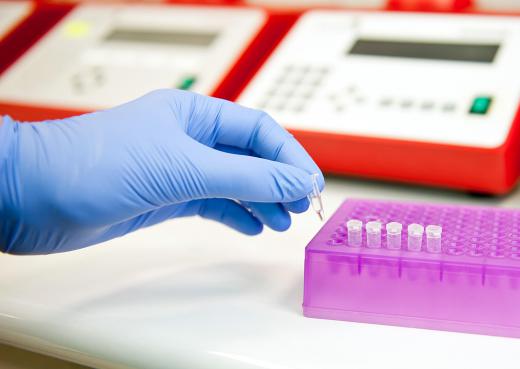What is a Viral Vector?
 Mary McMahon
Mary McMahon
A viral vector is a virus which has been modified in a laboratory environment for the purpose of introducing genetic material into a cell. There are a number of uses for viral vectors, including therapeutic treatments for disease, gene therapy, and pure research. Labs all over the world make viral vectors for their own research and produce vectors for use by other labs, and some companies specialize in the production and sale of viral vectors which can be customized by request.
The development of the viral vector dates to the 1960s, when a number of researchers recognized that since viruses operate by inserting genetic material into cells, surely researchers could harness this trait by modifying viruses to change the genetic material they are inserting. A viral vector is made by taking a virus, removing the harmful genetic material it uses to gain control of cells, and replacing it with desirable genetic material. The process of delivering genetic material with the use of a virus is known as transduction, with the first successful attempt occurring in 1968 with plant cells.

Adenoviruses, retroviruses, herpesviruses, and lentiviruses are popular choices for viral vectors. Modification of a virus to act as a viral vector is not as simple as removing some genes and splicing in new ones. The virus must be altered so that it is safe, with minimal toxicity, so that the cells it transducts are not inadvertently damaged or killed, and it must also be highly stable. Viral vectors can also be modified to target specific types of cells, which is of special interest to cancer researchers who want to created targeted therapies which go after tumor cells and nothing else.

The process of developing viral vectors can be painstaking and challenging, and an individual viral vector can take some time to create. Researchers may opt to insert genetic markers into the organisms they modify so that they can be easily identified, with the markers acting like a fingerprint which allows a vector to be traced to a particular project, researcher, or lab. This allows researchers to track their vectors when they share them, and in the event that they are released.
Viral vectors can be used for a wide variety of purposes in the medical community. They are also used to vaccinate plants against disease, and to conduct laboratory research which is designed to advance the sciences as a whole. There are also some unsavory potential uses for vectors; if they can be modified to introduce good genetic material, they can also be modified to introduce bad genetic material, which means that they could be applied in bioterrorism which is designed to hurt human, animal, or plant populations.
AS FEATURED ON:
AS FEATURED ON:












Discuss this Article
Post your comments